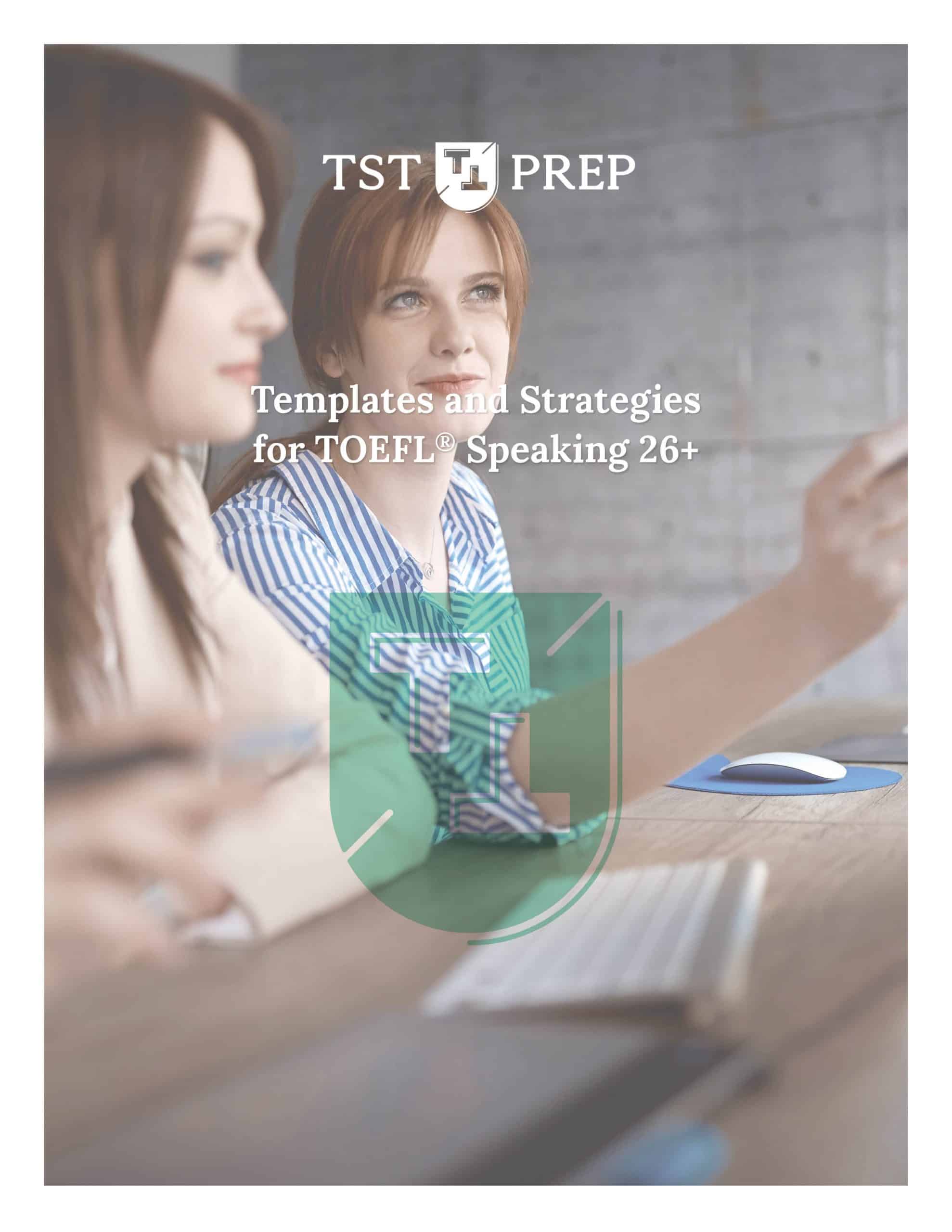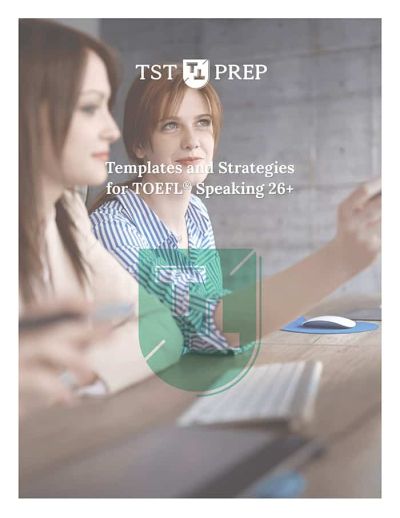Congratulations on reaching the final question in your TOEFL Speaking journey! Let’s talk about TOEFL question four and how to master it.
TOEFL Speaking question four asks you to listen to an academic lecture and then summarize it in your own words. How can you paraphrase an entire lecture in 60 seconds? It’s easier than you think.
Here’s how:
- Write out your note structure first – Knowing what information you are looking for will help you take better notes and filter out the noise.
- Identify the definition and example – The professor in the listening will describe the topic and provide a few examples of it. Write this down in your notes.
- Use transitional phrases – When it is time to speak, move smoothly between ideas by using the language ETS wants to hear.
- Think and speak like a teacher – You will sound more natural if you imagine explaining the topic to a child.
In this article, we will take you through each step so that you will feel comfortable and confident no matter what topic you get for TOEFL Speaking question four.
Let’s take a quick look at the structure of TOEFL Speaking question four.
1st – You will listen to an academic lecturer that typically lasts between 90-120 seconds.
2nd – The question will appear. You have 20 seconds to prepare your response.
3rd – Time to speak. You will have 60 seconds to speak.
We are going to take an in-depth look at TOEFL Speaking Question four. Listen to an example from one of our complete tests first so you can get an idea of what to expect on test day.
Speaking Task 4
Directions: You will now listen to part of a lecture. You will then be asked a question about it. After you hear the question, you will have 20 seconds to prepare your response and 60 seconds to speak.
Now, listen to part of a lecture in a business studies class
Now answer the question
Using points and details from the talk, explain what equity compensation is, and why companies might offer it to employees.
Preparation Time: 20 seconds
Response Time: 60 seconds
Speaking Task 4: Transcript
“OK, so, let’s continue our discussion of employee compensation. Today, I’d like to discuss a less common method of compensation, namely equity-based pay. In simple terms, under equity-based compensation, employees of the business receive part ownership of the company. This is usually in the form of shares or stocks. So, basically, employees are paid a usual hourly wage or yearly salary, but they also receive additional stock in the company. While this may sound like it cuts into profits, equity-based compensation could, in fact, help save a company money.
One benefit of equity based compensation is that it stops employees from leaving. Staff turnover, which is when employees quit, can be a big expense for many companies. Initial training takes weeks or even months, and is costly since trainees are not yet ready to contribute to the company’s bottom line. Some businesses feel that offering equity to employees makes them less likely to leave. The reason is that equity compensation plans typically reward employees with more stock the longer they stay with the company.
Not only can a company save money by utilizing an equity-based pay structure, but they may actually generate more profits by paying their workers in this manner. You see, another potential advantage of providing employees with stock options is that they are more likely to work harder to ensure the long-term success of the business. After all, if the company does well, its stock value will go up and any employee who owns equity will see their personal wealth rise too. Indeed, employees may actually go above and beyond their normal work duties to share information about their work on social media, email, and in conversation about their great job and its unique pay structure.”
Now that you have practiced with a real example from the TOEFL test, let’s go step-by-step through the process of listening to the lecture and answering the question well.
Tip #1: Write out your note structure first
If you want to take your TOEFL studies one step further, you can download our free PDF that includes over 100 Speaking Topics for the TOEFL Test
Example 2:
Details:
Tip #2: Identify the topic definition and examples
T: Stands for the topic. This topic is always found at the beginning of the lecture.
In this example the topic is “equity based pay” and the definition is “when employees of the business receive part ownership of the company.”
T: equity based pay
D: employees get part ownership
After the professor has stated the topic and defined it, he or she has to explain the information in more detail. For example, if the topic is about McDonald’s and the definition is an American fast-food company, you can expect the lecturer to give two examples like “they serve American food like hamburgers and French fries” and “they have over 10,00 locations in over 50 different countries”.
The idea is simple, after introducing the topic, the professor has to give more information to explain, in this situation the professor says:
So at this point, you should have the following information written down in your notes:
T: equity based pay
D: employees get part ownership
Ex1: 1 benefit, stops employees from leaving
D:
Ex2: benefit, employees work harder for success
Now you have a solid structure. As you listen to the rest of the lecture write down anything you think is important under the correct example.
Pro tip: You do not need to write full sentences or even complete words. Just enough so you can remember when you speak.
Here is an example of a good setup for your notes:
T: equity-based pay
D: employees get part ownership
Ex1: 1 benefit, stops employees from leaving
D: – staff turnover = big expense
– training employees is expensive
– people stay longer with equity
Ex2: benefit, employees work harder for success
D: – stock goes up, employee wage rises
– may share on social media
Tip #3: Use transitional phrases
Now as you prepare to speak, be sure to arm yourself with a memorized set of transition phrases.
What are transition phrases?
These are useful expressions to help you transition between ideas. Here are a few examples you probably already know:
- However,
- First of all
- For example
- In conclusion
Let’s start at the beginning of your response to question four. The good thing about the question is you can use the same introduction each time, such as:
“The professor in the lecture is talking about……….”
Then you will introduce the topic and a brief definition. For example,
“The professor in the lecturer is talking about equity-based compensation, which is basically when a company gives its employees stocks, in addition to their usual pay. ”
Then you can transition to the first example:
“First, the professor talks about…….”
Then talk about the first example:
“First, the professor talks about how equity-based compensation is a great way to keep employees for a longer period of time.”
Introducing the second example is even easier. You can use any one of these simple transition phrases:
- Also
- In addition
- Not to mention that
- Moreover
- Plus
Finally, with a few seconds left, go for a simple but effective conclusion
“And that is how the professor illustrates……(topic)”
Pro Tip: As you practice, be sure to practice with a timer to ensure you are on pace.
Basic Template: Question 4 |
||
|---|---|---|
| Template | Content | Time |
| The professor goes into a ton of detail about (topic), which (detail/definition) |
|
0-12 seconds |
| After introducing the topic, the lecturer mentions that (example 1 including details)... |
|
13-34 seconds |
| He/She goes on to say that (example 2 including details) |
|
34-55 seconds |
| So, after hearing this lecture, I now have a better understanding of (topic). |
|
56 - 60 seconds |
Tip #4: Sound like a teacher
Wait, don’t skip this part! Many people lose points on their response because they make one key mistake.
- When speaking, don’t try and read your notes. If you sound like you are reading, your score will be lower. Instead, pretend you are a teacher explaining this topic to a student.
You can listen to this example response to get an idea of how you should sound on test day.
Conclusion
So, let’s recap:
- Write out your note structure first– Knowing what information you are looking for will help you take better notes and filter out the noise.
- Identify the definition and examples – The professor in the listening will describe the topic and provide a few examples of it. Write this down in your notes.
- Use transitional phrases – When it is time to speak, move smoothly between ideas by using the language ETS wants to hear.
- Think and speak like a teacher – You will sound more natural if you imagine explaining the topic to a child.












11 Comments
Rodrigo Otaiza
This is Rock and Roll !
Thank you very much for this amazing and complete analysis.
You have no idea how helpful and useful this is.
Sheida
Thank you so much for the unique explanation of Toefl speaking questions as well as other tasks.
They are so helpful and I recommend it to everyone. 🙏
Josh
Thank you Sheida. Let me know if there is any other way I can help.
Lorena Stern
Thanks again for reminding me of tips for my students; they are very useful!!
Angell
To me it is impossible to speak as the example that you showed. I don’t know how to speak calm when I have a limited of time and the words don’t come to my mind.
Josh
Hi David and I totally understand the feeling. I have worked with a ton of students who feel the same way. Unfortunately, I don’t have a quick fix or magic pill for this, but the best approach is to take it slow and work on setting up conditions at home that you find relaxing. Slowly build up your confidence, adding more TOEFL-like variables until you can start answering in similar test conditions with less stress. there will always be stress, but you can work on reducing the amount of it over time.
Souvik Dasgupta
Is it necessary that we should always begin our answer with the phrase “in the lecture the professor talks about…”?
Because the question nowhere addresses the speaker or the professor.
So, can’t we directly go to the explanation of the subject? That will after all save more time.
Josh
Hi Souvik, and thank you for your thoughtful question. There are plenty of ways to score high on test day, and this is just a recommendation. However, you should consider the source of the information, in this instance, it was not a passage in a book but a lecture from a professor you have just heard, so it makes more sense to refer to “the professor” rather than just stating the facts stated in the audio passage. In the end, it is up to you and what you feel most comfortable doing, but I recommend referring to the professor.
Julie
Thank you very much for your recommendation Josh.
Mustafa
what is really diffucult for me is how to connect the sentences when professor jumps into the next one like is it okay to say THE PROFESSRO GOES ON TO SAY THAT….
Josh
Hi there and thank you for commenting. Here is a link to our guide with TOEFL Speaking templates, useful words and phrases, including transitions. I think it will help – https://s3.us-west-1.wasabisys.com/media.tstprep.com/freebies/toefl-speaking-26-templates-and-strategies.pdf